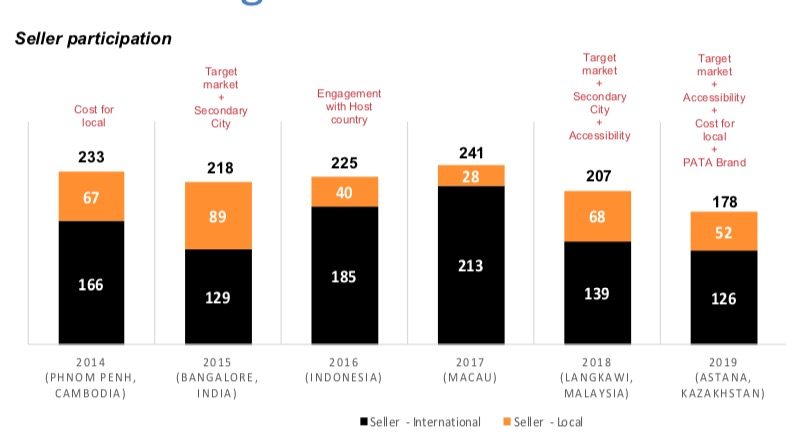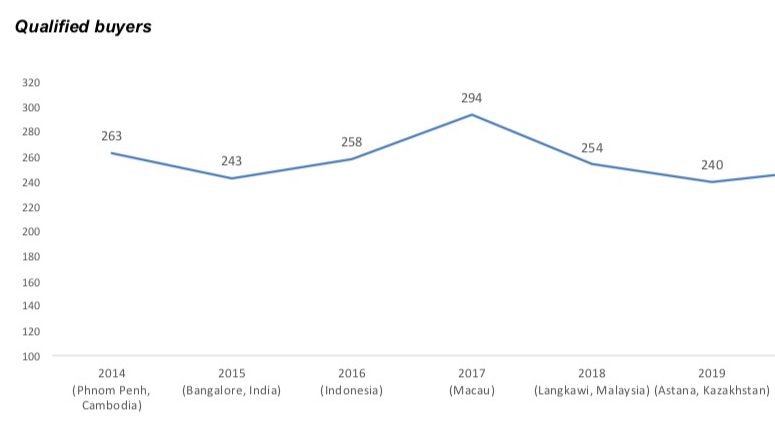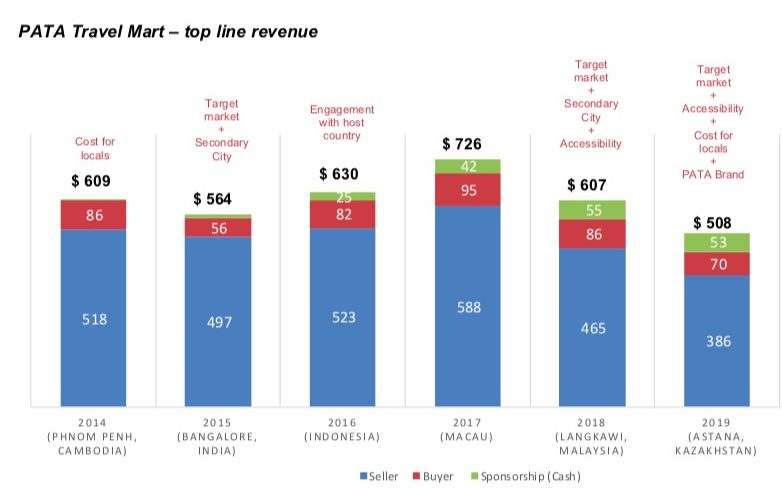
3 Oct, 2019
PATA Travel Mart 2019 slumps to all-time low
Bangkok – PATA’s primary money-spinning event, the Travel Mart held last month in Astana, Kazakhstan, hit an all-time low in terms of both attendance as well as financial performance.
According to an official PATA announcement, the Mart recorded “over 1,200 delegates from 63 global destinations. The delegate numbers embraced 347 sellers from 180 organisations and 34 destinations, along with 252 buyers from 244 organisations and 48 source markets with first time buyers comprising 44% of the total.”
All those figures were lower than the PTM 2018 in Langkawi, Malaysia, which attracted 1,400 delegates from 70 destinations. It included 389 sellers from 208 organisations and 33 destinations, and 252 buyers from 241 organisations in 53 source markets.
Financial reports presented to the PATA Board showed the following results of the PTM since 2014:



The Board was told that PTM’s overall revenue would by down by $186,000 ($156k from booth space and $30k from a last minute cancellation of sponsorship).
Asked to identify the reasons and lessons learnt, PATA CEO Mr Mario Hardy said, “The PATA Travel Mart was a great success for the host; we have exceeded their expectations in terms of attendance, visibility and promotion of the destination. We had over 1,200 delegates in total which is similar to what PATA had in recent years. The event still generated decent revenue and profit for the organisation. It is true, however, that the revenue was lower than what we had budgeted. I believe we had been a little over-enthusiastic with our forecast considering we were in a new region.”
PATA made some major miscalculations, which are being swept under the carpet. This, in spite of the association brandishing its vast experience in organising travel trade shows, and its line-up of “visionaries, thought-leaders and futurists” who can provide “exponential leadership” and “aligned advocacy.”
Although the mart was being heavily positioned as PATA’s first in Central Asia, Kazakhstan did not have much appeal either as an inbound or outbound market. Not many NTOs were interested in exhibiting there as against the more promising market of Russia.
Connectivity was a problem, especially for buyers and sellers coming from secondary cities in the Asia-Pacific region. The total cost of the accommodation, transportation, meals, etc, package became even higher if more than one delegate was sent.
All this is worsened by the intense competition amongst travel marts all around the region. PATA also had no brand image within Kazakhstan, which lowered the number of local participants, in spite of a company being hired on a commission basis to drum up business.
The Association had been stepping up its marketing efforts in the weeks prior to the PTM.
It tried to present the appeal of the destination thus: “PTM 2019 represents our first foray into Central Asia, at an exciting time when the region is starting to awaken to its incredible tourism potential. Given the destination’s allure and appeal, we encourage all industry colleagues to take advantage of this unique opportunity to explore Astana, Kazakhstan while contracting with buyers and sellers locally and worldwide.”
Another sales pitch marketed the “custom business matching software brings buyers and sellers together through pre-scheduled appointments, with buyers who actually have an interest in your product and have requested to meet you! PATA Travel Mart is 100% pre-matched appointments, facilitating over 10,000 meetings across two full days.”
It said, “Sellers will be bringing their latest and best tourism products to the table.” Another recent announcement proclaimed the attendance by 25 hosted buyers from China, “the top international source market in the world.”
Although the anti-climax will impact on PATA’s financials for 2019, it will work in favour of another policy in place over the last four years, viz., to reduce the financial reliance on the PTM by increasing the number of other events and stepping up the number of research publications. Both have generated results in the past year.
For example, the 2019 Adventure Market outperformed the budget projections with revenues of US$58,000 and a net surplus of US$55,000 (19% better than budget). An additional research project on sustainability has pulled in US$100,000 from Korea International Cooperation Agency. Earnings from another former big-ticket product, the EmPower statistical database service, have faded significantly.
Membership retention has increased slightly but the financial report showed that 10 major members owing just under US$130,000 had still not paid their dues.
The venue of the PTM 2020 has not been announced, but the budgetary projections are as rosy as ever.
Overall, the yearend financial performance is expected to be a little better than break-even. A major organisational restructuring is in the pipeline, set to be announced after approval at the annual general meeting in Ras Al Khaimah, UAE, in May 2019.



Liked this article? Share it!